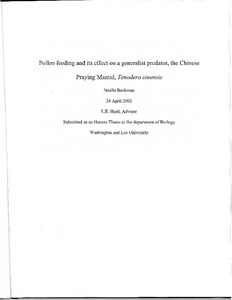| dc.rights.license | In Copyright | en_US |
| dc.creator | Beckman, Noelle Gabrielle | |
| dc.date.accessioned | 2023-04-21T19:15:38Z | |
| dc.date.available | 2023-04-21T19:15:38Z | |
| dc.date.created | 2002 | |
| dc.identifier | WLURG038_Beckman_thesis_2002 | |
| dc.identifier.uri | https://dspace.wlu.edu/handle/11021/36116 | |
| dc.description.abstract | The Chinese praying mantid, Tenodera sinensis (Saussure), is a univoltine generalist predator that hatches early in the spring and must oviposit in the fall. At both crucial times of early nymph development and oogenesis, mantids are food limited. Because pollen is abundant from trees and flowers at both times, I hypothesized that pollen feeding may benefit the mantid in nymph development, adult oogenesis, and decreased frequency in juvenile cannibalism. I tested these hypothesis in replicated laboratory experiments using varying diets of normal prey (flies, Drosophila melanogastor, for nymphs and crickets, Acheta domesticus, for adults) and one of two
pollen types: raw apple pollen or bee pollen. Mantid nymphs fed only raw pollen lived 37% longer than starved nymphs but died before molt. Mantid nymphs fed bee pollen successfully molted, but stayed in the first stadium approximately four times longer than nymphs fed flies and had a significantly lower mean body mass than fly-fed mantids at ecdysis. Pollen increased body mass of mantid nymphs fed flies at two densities, moderate and high. Adult female mantids fed bee pollen and crickets ate fewer crickets than mantids fed only crickets, and maintained the same fecundity in number of oothecae and estimated number of emerging nymphs. However, the availability of only bee pollen significantly increased the frequency of cannibalism in first stadium nymphs compared to starved nymphs and fly-fed nymphs. Nymphs fed only bee pollen cannibalized their siblings, whereas starved nymphs died without cannibalizing and nymphs fed flies did not cannibalize before ecdysis. Mantids can increase fitness with the consumption of pollen. The discovery that mantids eat pollen and gain benefits in the laboratory changes the trophic classification of mantids from carnivore to omnivore. | en_US |
| dc.format.extent | 66 pages | en_US |
| dc.language.iso | en_US | en_US |
| dc.rights | This material is made available for use in research, teaching, and private study, pursuant to U.S. Copyright law. The user assumes full responsibility for any use of the materials, including but not limited to, infringement of copyright and publication rights of reproduced materials. Any materials used should be fully credited with the source. | en_US |
| dc.rights.uri | http://rightsstatements.org/vocab/InC/1.0/ | en_US |
| dc.subject.other | Washington and Lee University -- Honors in Biology | en_US |
| dc.title | Pollen Feeding and Its Effect on a Generalist Predator, the Chinese Praying Mantid, Tenodera sinensis | |
| dc.type | Text | en_US |
| dcterms.isPartOf | WLURG38 - Student Papers | |
| dc.rights.holder | Beckman, Noelle Gabrielle | |
| dc.subject.fast | Praying mantis | en_US |
| dc.subject.fast | Pollen -- Environmental aspects | en_US |
| dc.subject.fast | Insects -- Physiology | en_US |
| local.department | Biology | en_US |
| local.scholarshiptype | Honors Thesis | en_US |
